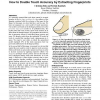Free Online Productivity Tools
i2Speak
i2Symbol
i2OCR
iTex2Img
iWeb2Print
iWeb2Shot
i2Type
iPdf2Split
iPdf2Merge
i2Bopomofo
i2Arabic
i2Style
i2Image
i2PDF
iLatex2Rtf
Sci2ools
CHI
2010
ACM
2010
ACM
The generalized perceived input point model and how to double touch accuracy by extracting fingerprints
It is generally assumed that touch input cannot be accurate because of the fat finger problem, i.e., the softness of the fingertip combined with the occlusion of the target by the finger. In this paper, we show that this is not the case. We base our argument on a new model of touch inaccuracy. Our model is not based on the fat finger problem, but on the perceived input point model. In its published form, this model states that touch screens report touch location at an offset from the intended target. We generalize this model so that it represents offsets for individual finger postures and users. We thereby switch from the traditional 2D model of touch to a model that considers touch a phenomenon in 3space. We report a user study, in which the generalized model explained 67% of the touch inaccuracy that was previously attributed to the fat finger problem. In the second half of this paper, we present two devices that exploit the new model in order to improve touch accuracy. Both model t...
| Added | 17 May 2010 |
| Updated | 17 May 2010 |
| Type | Conference |
| Year | 2010 |
| Where | CHI |
| Authors | Christian Holz, Patrick Baudisch |
Comments (0)

